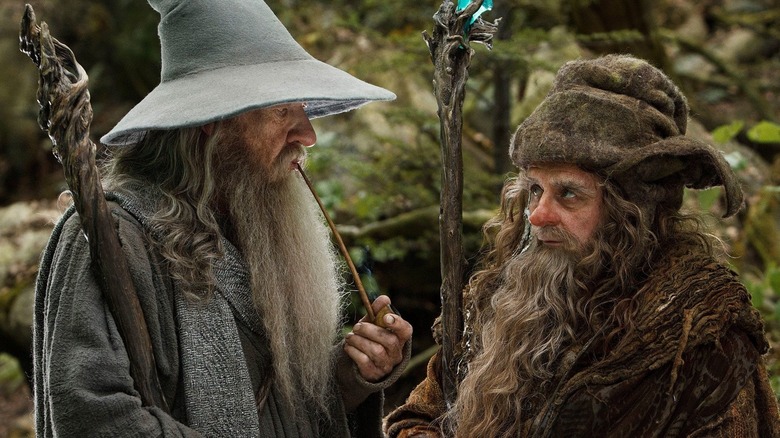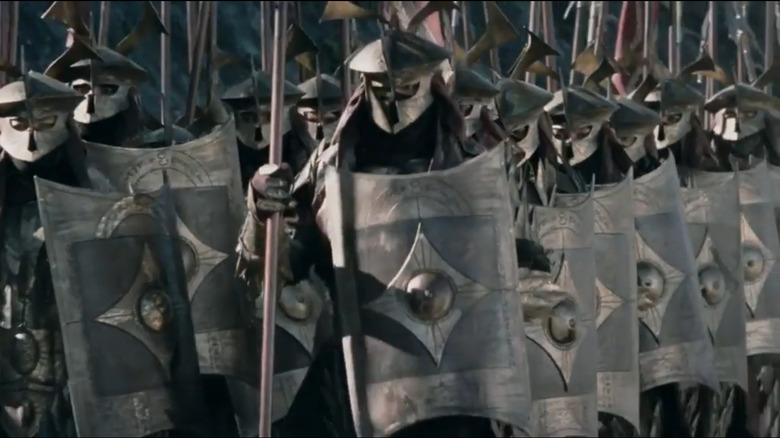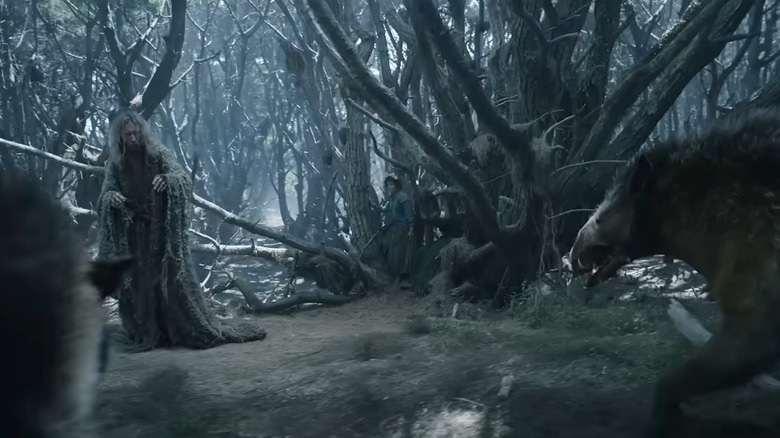The Blue Wizards In Middle-Earth Explained
J.R.R. Tolkien incorporated a lot of wizarding adventures into his stories. Gandalf (Ian McKellen) has a major impact on both "The Hobbit" and "The Lord of the Rings." Radagast's (Sylvester McCoy) effect is much smaller, but he's still on the periphery of those stories as well. And of course, Saruman (Christopher Lee) shakes things up by not just getting involved but doing it on the evil side of the ledger.
When Gandalf deposes Saruman in the "Two Towers" book, the ex-Wizard falsely accuses Gandalf of making a power grab, saying, "Yes, when you also have the Keys of Barad-dûr itself, I suppose; and the crowns of seven kings, and the rods of the Five Wizards, and have purchased yourself a pair of boots many sizes larger than those that you wear now." This is the first time we see a number connected to their wizarding order. The fact that there are "Five Wizards" instantly begs the question, where are the other two Wizards?
This mysterious pair of missing angelic beings is commonly referred to as the Blue Wizards, and the two characters have a fascinating — albeit uncertain — role in Middle-earth history. It's also worth noting that it's possible the supernatural Stranger (Daniel Weyman) in John D. Payne and Patrick McKay's "The Rings of Power" adaptation may be one of those Blue Wizards.
With that possibility hanging in the air, we decided to dig through the annals of Tolkienian lore to unearth the various scraps and mentions about the Blue Wizards and see just who these two guys are — and it turns out that it's a much harder question to answer than one might expect from Tolkien's typically meticulous fantasy creation.
Who are Tolkien's Wizards?
Before breaking down the Blue Wizards themselves, it's worth taking a minute to differentiate the author's wizarding order from the common wizards of fantasy and folklore. In the book "Unfinished Tales," Tolkien explains that the word "Wizard" translates to "istar" in Elvish and describes his Wizards (which is a formal title with an uppercase "W") as members of an order "claiming to possess, and exhibiting, eminent knowledge of the history and nature of the World" (via Tolkien Gateway). The Middle-earth author adds that while similar in name, his Istari are "distinct from the 'wizards' and 'magicians' of later legend."
When it comes to the number of Wizards in existence, we know about the Five Wizards thanks to "The Lord of the Rings." However, there's a chance that they're not the only ones. "Unfinished Tales" also says, "Of this Order the number is unknown; but of those that came to the North of Middle-earth, where there was most hope (because of the remnant of the Dúnedain and of the Eldar that abode there), the chiefs were five" (via Laurelin Archives). The text also adds that two of those five came over the sea to Middle-earth from the Blessed Realm in the West wearing sea-blue garb. Yep. That's our two Blue Wizards, right there.
So we know that Tolkien's Wizards were part of a distinct order of individuals that exists for a specific length of time. We also know there is an unknown number of total Wizards out there, but there are five chief Wizards ... and two of those Five Wizards arrive in sea-blue clothes. But where does this pair of azure magic-wielding angels wrapped in old-man bodies come from? For that, we turn back to "Unfinished Tales."
Interesting origins for Tolkien's Blue Wizards
In "Unfinished Tales," Tolkien's son, Christopher, talks about a jumble of his father's notes that detail a special council of the Valar (the angelic guardians of Middle-earth). At this meeting, they decide to send three emissaries to help the peoples of Middle-earth resist Sauron. One of these intermediaries is Saruman, who begrudgingly brings along Radagast. Another is Gandalf, who goes solo. The third envoy is a fellow named Alatar, who brings his friend Pallando (read: the Blue Wizards).
When it comes to the timing of their arrival in Middle-earth, there are two versions of the story. For a long time, Tolkien had all five primary Wizards arrive a thousand years into the Third Age (about 2,000 years before "The Lord of the Rings"). "Unfinished Tales" says that the Wizards "belonged solely to the Third Age and then departed" (via Tolkien Gateway), adding later that "they first appeared in Middle-earth about the year 1000 of the Third Age" (via Laurelin Archives). "The Return of the King" reinforces this, saying, "When maybe a thousand years had passed, and the first shadow had fallen on Greenwood the Great, the Istari or Wizards appeared in Middle-earth."
Interestingly, in the book "The Peoples of Middle-Earth," Tolkien changes this timeline, stating that while the three other Wizards still come later on, "the 'other two' came much earlier, at the same time probably as Glorfindel, when matters became very dangerous in the Second Age." This major rewrite would make the Blue Wizards an important, self-operating part of the Valar's Middle-earth rescue plan thousands of years before Gandalf, Saruman, and Radagast ever show up on the scene. The "correct" version, though, remains eternally shrouded in Tolkien's own uncertainty over the matter.
The bad Blues bamboozle the East
Okay, so we know that the Blue Wizards are sent by the Valar to resist Sauron. They arrive either early in the Second Age or with the other three Wizards in the Third Age. But ... what happens next? What do they do when they get to the mainland? It's a question that Tolkien himself grappled with throughout his life. In "Unfinished Tales," he says, "They never returned, and whether they remained in the East, ... or as some hold were ensnared by Sauron and became his servants, is not now known" (via Laurelin Archives).
The author emphasized this dark, unknown fate in a letter in 1958, in which he wrote, "I really do not know anything clearly about the other two [wizards] – since they do not concern the history of the N[orth].W[est]. I think they went as emissaries to distant regions, East and South, far out of Númenórean range: missionaries to 'enemy-occupied' lands, as it were."
Tolkien goes on to provide a damning summary of what he thinks happened to the long-lost Wizards: "What success they had I do not know; but I fear that they failed, as Saruman did, though doubtless in different ways; and I suspect they were founders or beginners of secret cults and 'magic' traditions that outlasted the fall of Sauron."
Okay. So based on Tolkien's initial take on these guys, they end up in a pretty bad place. The end, right? Wrong.
Wait, these are good guys after all?
In Tolkien's original vision of the Blue Wizards, they arrive with grand, anti-Sauron intentions. However, once they get to the front lines, they end up deviating in some pretty catastrophic ways, through either being corrupted by Sauron or creating their own cult followings. Either way, they follow Saruman's trajectory, failing in their purpose and leaving it to Gandalf to save the day. But that's not all she wrote (or in this case, all he wrote).
In "The Peoples of Middle-earth," we get one final version of the Blue Wizards that Tolkien wrote later in life. In this iteration of the story, we don't just get a few adjustments — we get a full rewrite. The text reads, "But the other two Istari were sent for a different purpose. Morinehtar and Rómestámo. Darkness-slayer and East-helper" (via The Tolkien Forum).
The note goes on to say that the two Blues (who have fantastically reimagined names in this version) are tasked with circumventing Sauron in the East. They help the tribes of Men who rebel against the Dark Lord, stir up rebellion, and generally cause dissension and disarray throughout Sauron's eastern strongholds. The brief note ends with the statement, "They must have had very great influence on the history of the Second Age and Third Age in weakening and disarraying the forces of East ... who would both in the Second Age and Third Age otherwise have ... outnumbered the West."
This major change turns the Blue Wizards into epic heroes whose anti-Sauron efforts in the East play an integral role in the ultimate overthrow of the Dark Lord in "The Lord of the Rings." So we get both fallen cult leaders and critical anti-Sauron agents — and both are equally vague and legitimate.
Is the Stranger on The Rings of Power a Blue Wizard?
The Blue Wizards play equally important roles as either Saruman or Gandalf. If you dig any deeper than these major character elements, though, you get, well, nothing. Zero. Zip. Nada. Tolkien just didn't get around to fleshing out who these guys were, leaving an interesting asterisk on the subject of the Blue Wizards, particularly as it pertains to "The Rings of Power."
The Middle-earth adaptation spends a significant portion of Season 1 establishing the Stranger, connecting him to the Harfoots, clarifying that he's a Wizard, and then sending him off toward Rhûn with little Nori (Markella Kavenagh) by his side. And yet with so much of the story fixed on him, we still don't know who this guy is. He could be Gandalf. After all, he talks, looks, and acts like Gandalf. The inclusion of the popular "Lord of the Rings" character would also be helpful for attracting new viewers who aren't familiar with deeper Tolkienian lore.
The only issue is, Gandalf doesn't arrive in Middle-earth until a thousand years after the story presented in "The Rings of Power" ends. In fact, in the original version of the tale, all the Wizards would arrive too late to be part of "The Rings of Power," which is set in the Second Age. However, the adjustment Tolkien made of the Blues arriving in the Second Age makes them perfect candidates for the show. The fact that he's heading east also jives with what little we know of the Blue Wizards' backstory. And yet the Stranger doesn't have a Wizard friend, begging the question, will we meet one later in the story? Or is the whole "go East, young Wizard" thing just a red herring?





